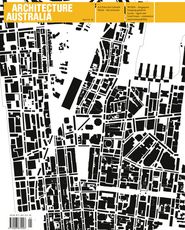Plantable press releases were one of the more curious items to come across the Architecture Australia desk last year. With the paper impregnated with seeds, the idea is that, once read, the press release is soaked, mushed up and planted. As the paper rots, the seeds germinate. One company even provided a pot complete with soil.
The gardener of our household dismissed them, along with the various packets of seeds that had fallen out of other PR envelopes. They were either for unidentifiable plants, or for species that he didn’t need or wouldn’t thrive in his garden. A colleague was more adventurous. She followed the instructions – she soaked, mushed, planted and waited. The result, she reports, was “a soggy, moulding mess … But, perhaps I wasn’t patient enough.”
Of course, the viability and ease of germinating seeds, and their appropriateness to the gardens of the recipients, is the secondary issue here. The primary function of the seeds trapped within that paper is as a sign. Like the eco washing powder and energy-saving light bulbs that also found their way onto my desk, they are a way of projecting various companies’ commitments to sustainability. Are they green bling, green wash, or do they signify more sustained and serious corporate efforts to address environmental concerns? It is hard to know and is probably different in each case.
Such green marketing indexes the much greater role sustainability now plays in the public consciousness, and the way it has infiltrated the worlds of commerce and development. As Scott Drake observes in this issue, sustainable buildings in the commercial sector were, for a long time, “a distant but unrealistic aspiration”. Now, “Five Star” and “Six Star” have become key phrases in the marketing of commercial space. This has its critics – those who argue that the various rating systems are expensive to implement and skew building and design practices toward strategies and material that rate highly, while other perhaps equally effective strategies are not accounted for. But, despite these concerns, the fact that “sustainability” is no longer solely the province of the remote house or the boutique demonstration project is surely a good thing, no matter the motivations (which are surely mixed, like most others).
Back to those seeds, light bulbs and packets of washing powder. They are also part of a much larger pool of “stuff” that washes around as PR agents seek to draw editorial attention to the activities of their clients. As part of this system, the eco-marketing items represent a peculiar conjunction of environmental concern and material excess.
Making this “stuff” productive rather than simply being green bling is partly the responsibility of the recipient – we should endeavour to make use of this unlooked-for material, and of the larger-scale opportunities that the combination of commerce and climate change bring. As Rob Adams and Greg Bamford differently suggest in this issue, the need to address issues of sustainability might also give us the chance to fix our cities.
First, plant your press release.
Justine Clark, editor Architecture Australia.















